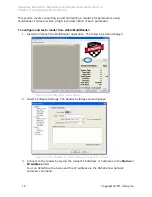
Speedway Revolution Installation and Operations Guide Octane 4.8
Chapter 2: Installing and Connecting
10
Copyright © 2011, Impinj, Inc.
Step 2: Connect the Antenna(s) to the Speedway Revolution Reader
Depending on the Speedway Revolution model you are installing, the reader has either two
antenna ports (R220) or four antenna ports (R420). Each port is independent, bidirectional,
and full duplex TX/RX (monostatic).
Warning:
You must use Impinj-approved antennas with Speedway Revolution.
See Appendix A:
Information Specific to Regions of Operation
on page 33 for a detailed list
of approved vendors. Using any other antenna may adversely affect performance or damage
the reader. Speedway Revolution requires professional installation to correctly set the TX
power for the RF cable and antenna selected.
To connect the antenna(s) to Speedway Revolution:
1.
Position each reader antenna, keeping the following points in mind:
•
Position the antenna(s) to achieve the most effective and efficient tag reads.
•
Position the antenna(s) to maximize operator safety. Personnel should remain at
a safe distance at all times. See Appendix A:
Information Specific to Regions of
Operation
on page 33for the specific requirements for your regulatory region.
2.
Mount the antenna(s) according to the instructions provided by the antenna
manufacturer.
3.
Attach the antenna cable(s) to the antenna port(s) on the reader. Choose any port
for any antenna.
Finger-tighten each connection, making sure the connection is secure. The antenna
cable is properly tightened when you are no longer able to twist the cable inside the
connector.
Note
: A loose connection negatively impacts the performance of the antenna.
Caution
: Impinj designed the Speedway Revolution antenna ports to be self-
terminating. It is important that you do not terminate unused antenna ports. Leave
them unconnected.
Step 3: Power the Reader
You have two choices for powering Speedway Revolution:
•
Power over Ethernet (PoE)
•
External universal power supply
If your network switch is PoE-enabled, the reader will power on when you connect it to the
network.
If you are using an external universal power supply, connect the AC power plug into a
suitable 100–240 VAC, 50–60 Hz power outlet.
The boot sequence begins in either case when power is supplied to the reader. This
sequence typically completes within 30 seconds. Once the boot sequence finishes, the
reader accepts commands, not before. The
Power and Status LEDs
on the reader alert you
the status. See Table 2.1 on page 8 for details.
!
Important:
If a reader is receiving power via PoE and the reader detects that an external
universal power supply has been connected, the reader reboots and switches to the external
universal power supply source. If, however, the reader is receiving power via an external
universal power supply and detects the connection to a PoE-enabled network switch,
nothing changes. The reader continues to receive power from the external supply. The
















































